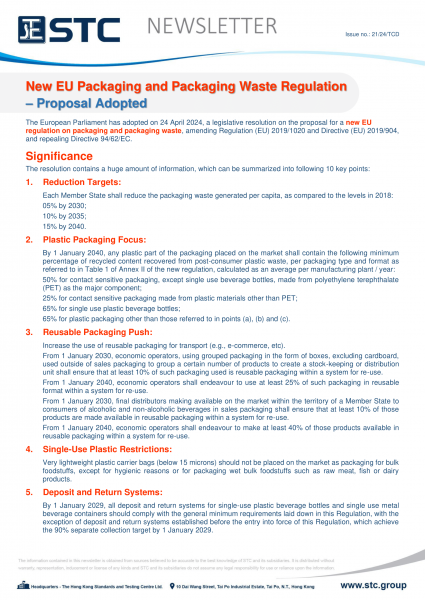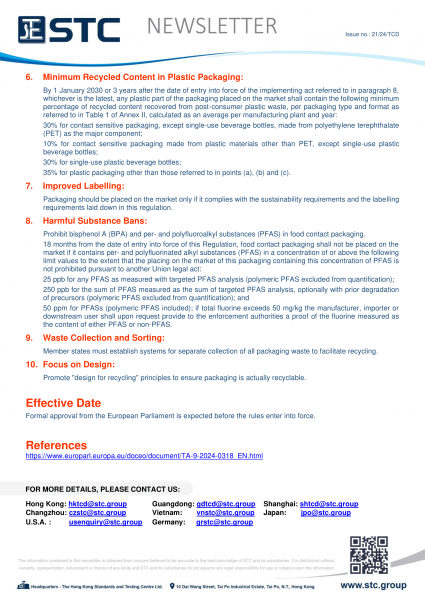
New EU Packaging and Packaging Waste Regulation – Proposal Adopted
The European Parliament has adopted on 24 April 2024, a legislative resolution on the proposal for a new EU regulation on packaging and packaging waste, amending Regulation (EU) 2019/1020 and Directive (EU) 2019/904, and repealing Directive 94/62/EC.
Significance
The resolution contains a huge amount of information, which can be summarized into following 10 key points.
1. Reduction Targets:
Each Member State shall reduce the packaging waste generated per capita, as compared to the levels in 2018:
05% by 2030;
10% by 2035;
15% by 2040.
2. Plastic Packaging Focus:
By 1 January 2040, any plastic part of the packaging placed on the market shall contain the following minimum percentage of recycled content recovered from post-consumer plastic waste, per packaging type and format as referred to in Table 1 of Annex II of the new regulation, calculated as an average per manufacturing plant / year:
50% for contact sensitive packaging, except single use beverage bottles, made from polyethylene terephthalate (PET) as the major component;
25% for contact sensitive packaging made from plastic materials other than PET;
65% for single use plastic beverage bottles;
65% for plastic packaging other than those referred to in points (a), (b) and (c).
3. Reusable Packaging Push:
Increase the use of reusable packaging for transport (e.g., e-commerce, etc).
From 1 January 2030, economic operators, using grouped packaging in the form of boxes, excluding cardboard, used outside of sales packaging to group a certain number of products to create a stock-keeping or distribution unit shall ensure that at least 10% of such packaging used is reusable packaging within a system for re-use.
From 1 January 2040, economic operators shall endeavour to use at least 25% of such packaging in reusable format within a system for re-use.
From 1 January 2030, final distributors making available on the market within the territory of a Member State to consumers of alcoholic and non-alcoholic beverages in sales packaging shall ensure that at least 10% of those products are made available in reusable packaging within a system for re-use.
From 1 January 2040, economic operators shall endeavour to make at least 40% of those products available in reusable packaging within a system for re-use.
4. Single-Use Plastic Restrictions:
Very lightweight plastic carrier bags (below 15 microns) should not be placed on the market as packaging for bulk foodstuffs, except for hygienic reasons or for packaging wet bulk foodstuffs such as raw meat, fish or dairy products.
5. Deposit and Return Systems:
By 1 January 2029, all deposit and return systems for single-use plastic beverage bottles and single use metal beverage containers should comply with the general minimum requirements laid down in this Regulation, with the exception of deposit and return systems established before the entry into force of this Regulation, which achieve the 90% separate collection target by 1 January 2029.
6. Minimum Recycled Content in Plastic Packaging:
By 1 January 2030 or 3 years after the date of entry into force of the implementing act referred to in paragraph 8, whichever is the latest, any plastic part of the packaging placed on the market shall contain the following minimum percentage of recycled content recovered from post-consumer plastic waste, per packaging type and format as referred to in Table 1 of Annex II, calculated as an average per manufacturing plant and year:
30% for contact sensitive packaging, except single-use beverage bottles, made from polyethylene terephthalate (PET) as the major component;
10% for contact sensitive packaging made from plastic materials other than PET, except single-use plastic beverage bottles;
30% for single-use plastic beverage bottles;
35% for plastic packaging other than those referred to in points (a), (b) and (c).
7. Improved Labelling:
Packaging should be placed on the market only if it complies with the sustainability requirements and the labelling requirements laid down in this regulation.
8. Harmful Substance Bans:
Prohibit bisphenol A (BPA) and per- and polyfluoroalkyl substances (PFAS) in food contact packaging.
18 months from the date of entry into force of this Regulation, food contact packaging shall not be placed on the market if it contains per- and polyfluorinated alkyl substances (PFAS) in a concentration of or above the following limit values to the extent that the placing on the market of this packaging containing this concentration of PFAS is not prohibited pursuant to another Union legal act:
25 ppb for any PFAS as measured with targeted PFAS analysis (polymeric PFAS excluded from quantification);
250 ppb for the sum of PFAS measured as the sum of targeted PFAS analysis, optionally with prior degradation of precursors (polymeric PFAS excluded from quantification); and
50 ppm for PFASs (polymeric PFAS included); if total fluorine exceeds 50 mg/kg the manufacturer, importer or downstream user shall upon request provide to the enforcement authorities a proof of the fluorine measured as the content of either PFAS or non-PFAS.
9. Waste Collection and Sorting:
Member states must establish systems for separate collection of all packaging waste to facilitate recycling.
10. Focus on Design:
Promote "design for recycling" principles to ensure packaging is actually recyclable.
Effective Date
Formal approval from the European Parliament is expected before the rules enter into force.
References
https://www.europarl.europa.eu/doceo/document/TA-9-2024-0318_EN.html











